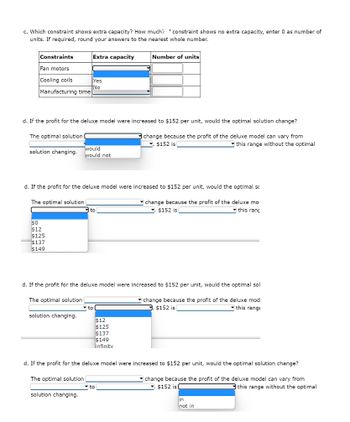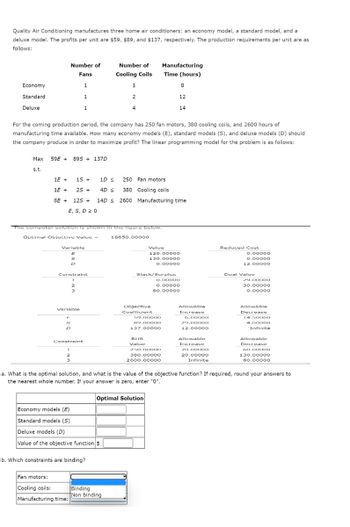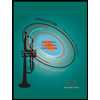
Practical Management Science
6th Edition
ISBN: 9781337406659
Author: WINSTON, Wayne L.
Publisher: Cengage,
expand_more
expand_more
format_list_bulleted
Question

Transcribed Image Text:c. Which constraint shows extra capacity? How much? constraint shows no extra capacity, enter 0 as number of
units. If required, round your answers to the nearest whole number.
Constraints
Fan motors
Cooling coils
Manufacturing time
The optimal solution
solution changing.
d. If the profit for the deluxe model were increased to $152 per unit, would the optimal solution change?
change because the profit of the deluxe model can vary from
$152 is
this range without the optimal
The optimal solution
Extra capacity
$0
$12
$125
$137
$149
Yes
†No
d. If the profit for the deluxe model were increased to $152 per unit, would the optimal sc
change because the profit of the deluxe mo
$152 is
this rang
solution changing.
would
would not
to
d. If the profit for the deluxe model were increased to $152 per unit, would the optimal sol
The optimal solution
change because the profit of the deluxe mod
$152 is
this range
solution changing.
Number of units
to
$12
$125
$137
$149
linfinitv
d. If the profit for the deluxe model were increased to $152 per unit, would the optimal solution change?
The optimal solution
change because the profit of the deluxe model can vary from
$152 is (
this range without the optimal
to
in
not in

Transcribed Image Text:Quality Air Conditioning manufactures three home air conditioners: an economy model, a standard model, and a
deluxe model. The profits per unit are $59, $89, and $137, respectively. The production requirements per unit are as
follows:
Economy
Standard
Deluxe
Max
s.t.
Number of
Fans
1
1
1
59E+ 895 + 137D
1E +
1E +
For the coming production period, the company has 250 fan motors, 380 cooling coils, and 2600 hours of
manufacturing time available. How many economy models (E), standard models (S), and deluxe models (D) should
the company produce in order to maximize profit? The linear programming model for the problem is as follows:
15 +
25 +
Optimal Objective Value =
Variable
E
S
D
250 Fan motors
380 Cooling coils
8E + 125 + 14D ≤ 2600 Manufacturing time
E, S, D 20
Constrainal
1
2
3
The computer solution is shown in the figure below.
Variable
D
Constraint
1D S
4D S
Fan motors:
Cooling coils:
Manufacturing time:
Number of
Cooling Coils
b. Which constraints are binding?
1
2
4
Economy models (E)
Standard models (S)
Deluxe models (D)
Value of the objective function $
Binding
Non binding
18650.00000
Manufacturing
Time (hours)
Slack/Surplus
Objective
Coefficient
RIIS
Value
Value
120.00000
130.00000
0.00000
59.00000
89.00000
137.00000
Optimal Solution
8
12
14
0.00000
0.00000
80.00000
250.00000
380.00000
2600.00000
Allowable
Increase
6.00000
29.00000
12.00000
Allowable
Increase
20.00000
20.00000
Infinite
Reduced Cost
0.00000
0.00000
12.00000
Dual Value
29.00000
30.00000
0.00000
a. What is the optimal solution, and what is the value of the objective function? If required, round your answers to
the nearest whole number. If your answer is zero, enter "0".
Allowable
Decrease
14.50000
4.00000
Infinite
Allowable
Decrease
60.00000
130.00000
80.00000
Expert Solution
This question has been solved!
Explore an expertly crafted, step-by-step solution for a thorough understanding of key concepts.
This is a popular solution
Trending nowThis is a popular solution!
Step by stepSolved in 2 steps with 5 images

Knowledge Booster
Similar questions
- In one fiscal year, firm B has ROA (return on asset) of 5%, and they borrow a substantial amount of money from banks to finance their operations. Except for that, the firm has no debt. Suppose the interest rate for the loans is 6%. What will this firm's ROE (return on equity) be? Group of answer choices More than 5% Less than 5% Less than 4% More than 4% Please ANSWER ASAParrow_forwardPlease do not give solution in image format thankuarrow_forwardNeed help only with finding the optimal solutionarrow_forward
- I need solution of 2.34 as possible as pleasearrow_forwardblank one options: increases OR decreases OR remains unchanged Blank two options: increases OR decreases OR remains unchanged Blank three options: increases OR decreases OR remains unchangedarrow_forwardPLEASE USE SIMPLEX METHOD. Thank you! Suppose a company manufactures different electronic components for computers. Component A requires 2 hours of fabrication and an hour of assembly. Component B requires 3 hours of fabrication and an hour of assembly, and component C requires 2 hours of fabrication and 2 hours of assembly. The company has upto 1,000 labor-hours for fabrication, 800 labor-hours of assembly time each work. If the profit on each component A, B, and C is $7, $8, and $10 respectively, how many of each should be produced to maximize profit?arrow_forward
- John is travelling from home in Sydney to a hotel in Perth. Three stopovers on the way a number of choices of towns for each stop only one hotel to choose from in each town, except for Perth, where there are three hotels (J, K, and L) to choose from Each trip has a different distance resulting in a different cost (petrol) (cost is marked by each arc) Hotels have different costs (cost is marked by each node (town)) ● ● ● The goal is to select a route to and a hotel in Perth so that the overall cost of the trip is minimized. Use dynamic programming (forward recursion) to solve this problem by constructing the usual tables for each stage. Stage: 0 (Sydney) 1 Petrol cost start 22 8 12 Hotel cost 70 80 B 80 25 10 2 50 A E 70 30 10 18 8 7 3 50 F 70 70 H 60 8 10 10 4 (Perth) 50 13 K 10 15 L 60 70arrow_forwardProblem 7-41 Southern Oil Company produces two grades of gasoline: regular and premium. The profit contributions are $0.30 per gallon for regular gasoline and $0.50 per gallon for premium gasoline. Each gallon of regular gasoline contains 0.3 gallons of grade A crude oil and each gallon of premium gasoline contains 0.6 gallons of grade A crude oil. For the next production period, Southern has 18,000 gallons of grade A crude oil available. The refinery used to produce the gasolines has a production capacity of 50,000 gallons for the next production period. Southern Oil's distributors have indicated that demand for the premium gasoline for the next production period will be at most 20,000 gallons. a. Formulate linear programming model that can be used to determine the number of gallons of regular gasoline and the number of gallons of premium gasoline that should be produced in order to maximize tota profit contribution. If required, round your answers to two decimal places. L Let R = P =…arrow_forward19. Solve for n, C(n, 4) = 210 Solve it accurate solve it correct complete solutionsarrow_forward
arrow_back_ios
arrow_forward_ios
Recommended textbooks for you
 Practical Management ScienceOperations ManagementISBN:9781337406659Author:WINSTON, Wayne L.Publisher:Cengage,
Practical Management ScienceOperations ManagementISBN:9781337406659Author:WINSTON, Wayne L.Publisher:Cengage, Operations ManagementOperations ManagementISBN:9781259667473Author:William J StevensonPublisher:McGraw-Hill Education
Operations ManagementOperations ManagementISBN:9781259667473Author:William J StevensonPublisher:McGraw-Hill Education Operations and Supply Chain Management (Mcgraw-hi...Operations ManagementISBN:9781259666100Author:F. Robert Jacobs, Richard B ChasePublisher:McGraw-Hill Education
Operations and Supply Chain Management (Mcgraw-hi...Operations ManagementISBN:9781259666100Author:F. Robert Jacobs, Richard B ChasePublisher:McGraw-Hill Education
 Purchasing and Supply Chain ManagementOperations ManagementISBN:9781285869681Author:Robert M. Monczka, Robert B. Handfield, Larry C. Giunipero, James L. PattersonPublisher:Cengage Learning
Purchasing and Supply Chain ManagementOperations ManagementISBN:9781285869681Author:Robert M. Monczka, Robert B. Handfield, Larry C. Giunipero, James L. PattersonPublisher:Cengage Learning Production and Operations Analysis, Seventh Editi...Operations ManagementISBN:9781478623069Author:Steven Nahmias, Tava Lennon OlsenPublisher:Waveland Press, Inc.
Production and Operations Analysis, Seventh Editi...Operations ManagementISBN:9781478623069Author:Steven Nahmias, Tava Lennon OlsenPublisher:Waveland Press, Inc.

Practical Management Science
Operations Management
ISBN:9781337406659
Author:WINSTON, Wayne L.
Publisher:Cengage,

Operations Management
Operations Management
ISBN:9781259667473
Author:William J Stevenson
Publisher:McGraw-Hill Education

Operations and Supply Chain Management (Mcgraw-hi...
Operations Management
ISBN:9781259666100
Author:F. Robert Jacobs, Richard B Chase
Publisher:McGraw-Hill Education


Purchasing and Supply Chain Management
Operations Management
ISBN:9781285869681
Author:Robert M. Monczka, Robert B. Handfield, Larry C. Giunipero, James L. Patterson
Publisher:Cengage Learning

Production and Operations Analysis, Seventh Editi...
Operations Management
ISBN:9781478623069
Author:Steven Nahmias, Tava Lennon Olsen
Publisher:Waveland Press, Inc.